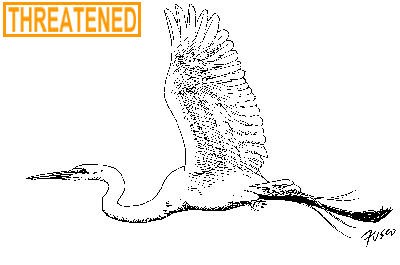Great Egret
Ardea albus

Habitat: Freshwater and saltwater marshes, streams, ponds, lakes, and mud flats. In Connecticut, typically nest on uninhabited offshore islands in Long Island Sound.
Weight: 32-40 ounces.
Length: 38 inches.
Wingspan: 55 inches.
Life Expectancy: Some banded birds have lived more than 22 years.
Food: Fishes, frogs, salamanders, snakes, crayfish, mice, aquatic insects, crickets, grasshoppers, and a variety of other insects.
Status: State threatened.
Identification: The great egret is a large member of the heron family, with long legs, white plumage, and a slender body. Adults have black legs and feet. During the breeding season, the normally yellow bill may appear orange and long feather plumes (aigrettes) extend from the back to beyond the tail. Immature egrets and non-breeding adults have no plumes and the color of their bills and legs is duller. The wings of the great egret are proportionately longer and broader than most other white herons. In flight, the great egret holds its neck in a more open S-shape than do other white herons. The species utters a loud, low-pitched, hoarse croak. The sexes are similar in appearance but males are slightly larger.
Range: The great egret occurs from Maine and southern Canada west to the Great Lakes, south to Texas, the Gulf Coast states, Florida, and along the Atlantic Coast.
Reproduction: The great egret usually nests in colonies with other heron species in wooded swamps and wetlands. Nests are typically built 20 to 40 feet above ground in medium-sized trees. Occasionally they are built in bushes or cattails, 1 to 4 feet above water. The nest is a large, flat platform, constructed of sticks and twigs and usually lined with small pieces of plant material. Nest building is normally started by the male, who then brings materials to the female for her to finish building the nest.
The breeding season begins in mid-April but varies with yearly weather patterns. The single clutch of 4 to 5 oval, smooth, greenish-blue eggs is incubated for 23 to 24 days. When the nestlings hatch, they are semi-altricial (mostly helpless), with long, white down that has fine, silky tips. The nestlings have pink bills that eventually turn yellow. Both adults tend the young. After about 3 weeks, the young egrets leave the nest and walk among nearby branches, returning to the nest to be fed. A week later, they are fed away from the nest and usually begin taking short flights 35 to 40 days after hatching.
Reason for Decline: At the beginning of the twentieth century, great egret populations came close to extinction due to excessive market hunting. The species' feather plumes were in great demand for use in women's apparel. Although populations recovered somewhat after market hunting was outlawed and legal protection was established, the degradation and loss of wetland habitats and the development of coastal areas have prevented populations from returning to their previous levels. Disturbance to rookeries, either by predators or people, continues to hamper recovery efforts.
History in Connecticut: The great egret was a "very rare" Connecticut visitor by the mid-1800s due, in large part, to market hunting. Protective legislation passed in the early 1900s helped populations stablize. By the 1920s, egrets were increasingly seen along the Connecticut coastline during migration. In the 1940s, they were regular coastal visitors and were even spotted in the Waterbury and Hartford areas. The first recorded great egret nest in Connecticut was in the Norwalk Islands in 1961. Today, the great egret nests in limited numbers on offshore islands along Connecticut's coast. The birds can be seen at many inland areas during migration and after the breeding season as they search for food.
Interesting Facts: Great egrets do not feed at night like some other heron species. They either forage alone or in mixed flocks, often by slowly walking in shallow water.
The great egret has also been called the American egret, common egret, great white egret, and angel bird.
Protective Legislation: Federal - Migratory Bird Treaty Act of 1918; State - Connecticut General Statutes Sec. 26-311.
What You Can Do: The loss of wetland habitats is one of the greatest threats facing Connecticut's nesting great egrets. To help the birds, encourage the protection, conservation and restoration of Connecticut's wetland habitats. The protection of offshore island nesting areas is extremely important. During the breeding and nesting seasons, visitors to these islands should respect temporary fencing and area closures at and near nest sites.

The production of this Endangered and Threatened Species Fact Sheet
Series is made possible by donations to the Endangered Species/Wildlife Income Tax
Checkoff Fund.
(rev. 12/99)

